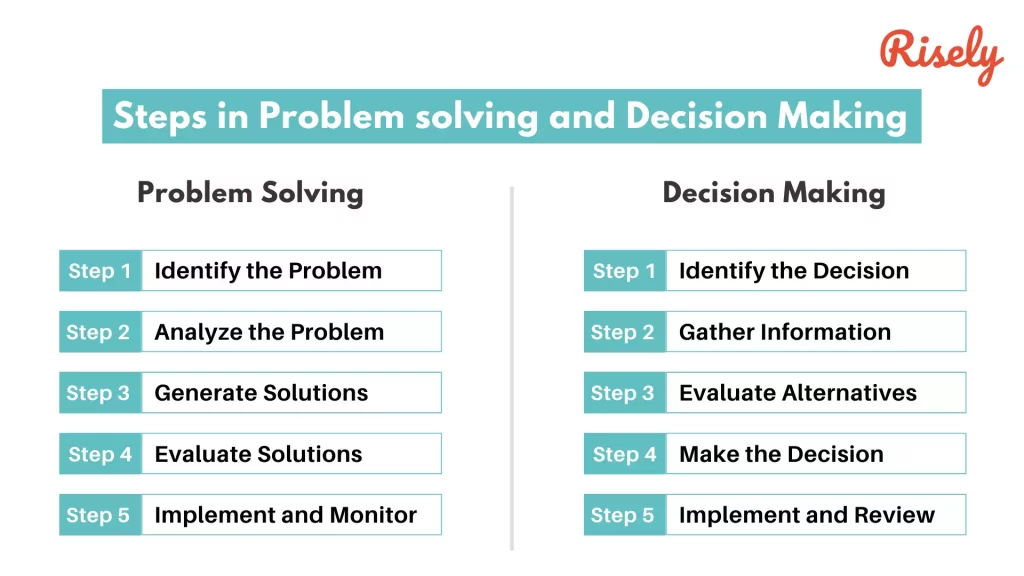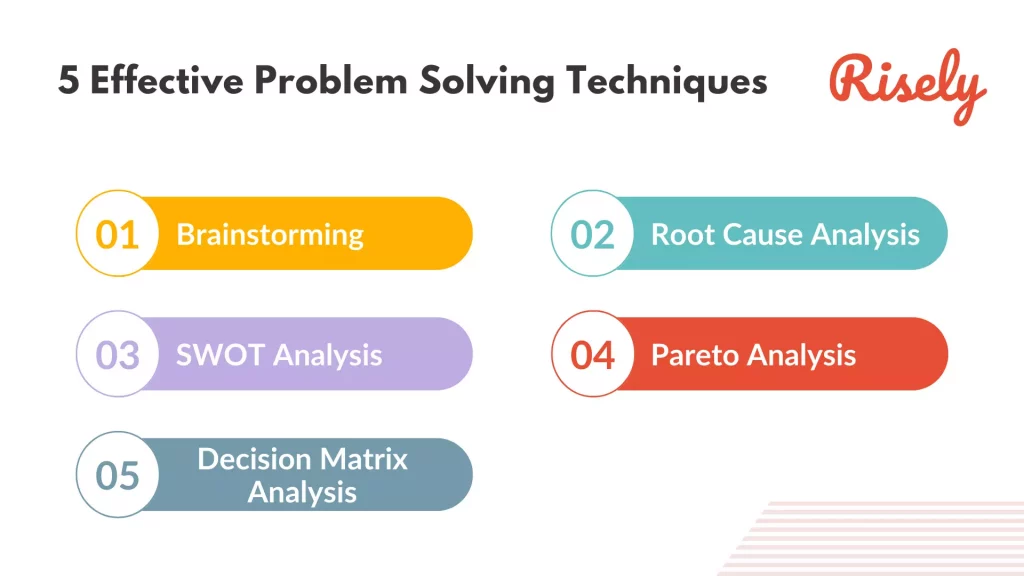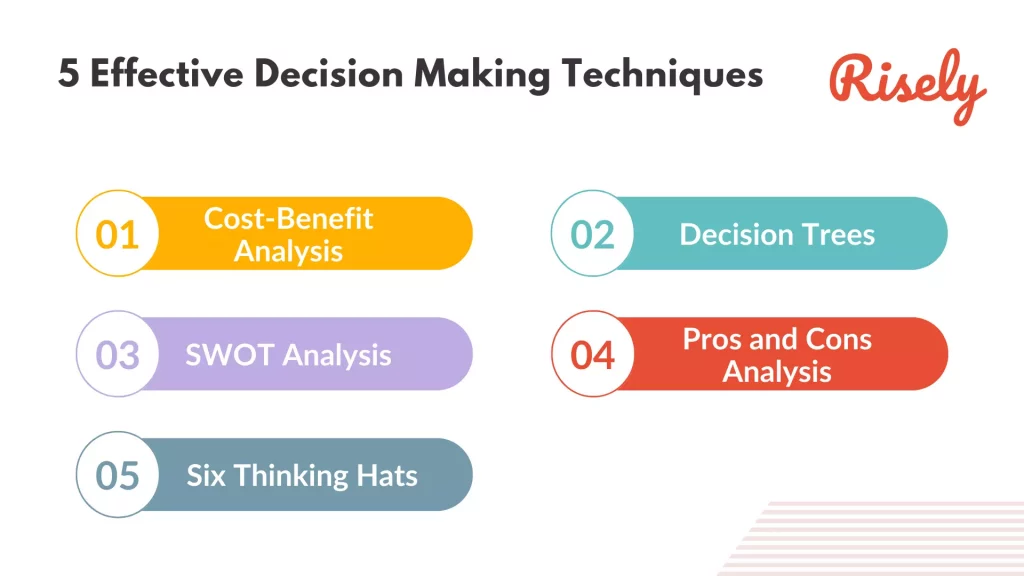Problem Solving And Decision Making: 10 Hacks That Managers Love
In life, we face various problems that require us to make decisions. Some are small and quickly resolved, while others can be more complex and challenging. But what if you could master the art of problem solving and decision making? In this post, we will delve deep into what problem solving and decision making are, their importance, and the science behind them. We will also provide you with ten proven techniques to help you tackle problems and easily make sound decisions. From Root Cause Analysis to Vroom-Yetton Decision Model, we have got it all covered in this comprehensive guide to mastering the art of problem solving and decision making. So buckle up as we take you on an insightful journey toward becoming a problem solving pro!Understanding Problem Solving & Decision Making
Problem solving and decision making are related concepts often used together, but they are not the same. Here is a brief explanation of the difference between problem solving and decision making: Problem solving: Problem solving is identifying, analyzing, and resolving problems or issues. It involves specifying the root cause of a problem and finding solutions to overcome it. Problem solving requires critical thinking, creativity, and analytical skills. It is a process that can resolve simple and complex problems in various contexts, such as personal, professional, and organizational settings. Decision making: Decision making is the process of choosing a course of action from among several alternatives. It involves evaluating options, considering consequences, and selecting the best course of action based on the available information and criteria. Decision making requires critical thinking, judgment, and evaluation skills. It is a process that can be used to make simple and complex decisions in various contexts, such as personal, professional, and organizational settings.
Why are problem solving and decision making skills essential in the workplace?
Effective problem solving and decision making skills are essential in the workplace for several reasons:- Improved efficiency and productivity: Employees with strong problem solving and decision making skills are better equipped to identify and solve issues that may arise in their work. This leads to improved efficiency and productivity as they can complete their work more timely and effectively.
- Improved customer satisfaction: Problem solving and decision making skills also help employees address any concerns or issues customers may have. This leads to enhanced customer satisfaction as customers feel their needs are being addressed and their problems are resolved.
- Effective teamwork: When working in teams, problem solving and decision making skills are essential for effective collaboration. Groups that can effectively identify and solve problems together are more likely to successfully achieve their goals.
- Innovation: Effective problem-solving and decision-making skills are also crucial for driving innovation in the workplace. Employees who think creatively and develop new solutions to problems are more likely to develop innovative ideas to move the business forward.
- Risk management: Problem solving and decision making skills are also crucial for managing risk in the workplace. By identifying potential risks and developing strategies to mitigate them, employees can help minimize the negative impact of risks on the business.
Five Techniques for Effective Problem Solving
Here are five different techniques and strategies for problem solving, along with an example of how each one could be used:
- Brainstorming: Brainstorming is a technique for generating creative ideas and solutions to problems. In a brainstorming session, a group of people share their thoughts and build on each other’s suggestions. The goal is to generate a large number of ideas in a short amount of time. For example, a team of engineers could use brainstorming to develop new ideas for improving the efficiency of a manufacturing process.
- Root Cause Analysis: Root cause analysis is a technique for identifying the underlying cause of a problem. It involves asking “why” questions to uncover the root cause of the problem. Once the root cause is identified, steps can be taken to address it. For example, a hospital could use root cause analysis to investigate why patient falls occur and identify the root cause, such as inadequate staffing or poor lighting.
- SWOT Analysis: SWOT analysis is a technique for evaluating the strengths, weaknesses, opportunities, and threats related to a problem or situation. It involves assessing internal and external factors that could impact the problem and identifying ways to leverage strengths and opportunities while minimizing weaknesses and threats. For example, a small business could use SWOT analysis to evaluate its market position and identify opportunities to expand its product line or improve its marketing.
- Pareto Analysis: Pareto analysis is a technique for identifying the most critical problems to address. It involves ranking problems by impact and frequency and first focusing on the most significant issues. For example, a software development team could use Pareto analysis to prioritize bugs and issues to fix based on their impact on the user experience.
- Decision Matrix Analysis: Decision matrix analysis evaluates alternatives and selects the best course of action. It involves creating a matrix to compare options based on criteria and weighting factors and selecting the option with the highest score. For example, a manager could use decision matrix analysis to evaluate different software vendors based on criteria such as price, features, and support and select the vendor with the best overall score.
Five Techniques for Effective Decision Making
Here are five effective techniques and strategies for decision making, along with an example of how each one could be used:
- Cost-Benefit Analysis: Cost-benefit analysis is a technique for evaluating the costs and benefits of different options. It involves comparing each option’s expected costs and benefits and selecting the one with the highest net benefit. For example, a company could use cost-benefit analysis to evaluate a new product line’s potential return on investment.
- Decision Trees: Decision trees are a visual representation of the decision-making process. They involve mapping out different options and their potential outcomes and probabilities. This helps to identify the best course of action based on the likelihood of different outcomes. For example, a farmer could use a decision tree to choose crops to plant based on the expected weather patterns.
- SWOT Analysis: SWOT analysis can also be used for decision making. By identifying the strengths, weaknesses, opportunities, and threats of different options, a decision maker can evaluate each option’s potential risks and benefits. For example, a business owner could use SWOT analysis to assess the potential risks and benefits of expanding into a new market.
- Pros and Cons Analysis: Pros and cons analysis lists the advantages and disadvantages of different options. It involves weighing the pros and cons of each option to determine the best course of action. For example, an individual could use a pros and cons analysis to decide whether to take a job offer.
- Six Thinking Hats: The six thinking hats technique is a way to think about a problem from different perspectives. It involves using six different “hats” to consider various aspects of the decision. The hats include white (facts and figures), red (emotions and feelings), black (risks and drawbacks), yellow (benefits and opportunities), green (creativity and new ideas), and blue (overview and control). For example, a team could use the six thinking hats technique to evaluate different options for a marketing campaign.
Conclusion
In conclusion, mastering problem-solving and decision-making techniques are essential for personal and professional success. It allows you to make informed decisions, solve complex problems, and quickly achieve your goals. By using these ten techniques effectively, you can enhance your problem solving and decision making abilities and become a more productive and efficient individual. So, start practicing these techniques today to get closer to your goals. Want to learn more about how to master the art of problem solving and decision making?How strong are your decision making skills?
Find out now with the help of Risely’s free assessment for leaders and team managers.
Frequently Asked Questions
How are problem solving and decision making related?
Problem solving and decision making are closely related concepts, as effective problem solving involves identifying potential solutions and making informed decisions about which solution to pursue. To make a good decision, it is often necessary to engage in problem solving by gathering information, analyzing options, and weighing the pros and cons of different choices. Ultimately, problem solving and decision making require critical thinking skills and the ability to evaluate information logically and systematically.
What is a good example of decision-making?
A good example of decision-making is carefully considering all available options, weighing the pros and cons, and choosing based on what aligns with your values and goals. For instance, deciding to go back to school to further your education or accepting a job offer based on factors like salary, benefits, and work-life balance can be good examples of effective decision-making.
What are the steps in problem-solving and decision-making?
The steps in problem-solving and decision-making can vary depending on the situation. Still, some common steps include identifying the problem, gathering information and analyzing it, generating potential solutions or options, evaluating the pros and cons of each option, making a decision, and taking action to implement the chosen solution. It is essential to reflect on the process and outcome to learn from mistakes or improve future decision-making.
Other Related Blogs
10 Signs You’re Struggling with Analysis Paralysis at Work
10 Signs You’re Struggling with Analysis Paralysis at Work The smart fox declares, “I have a hundred ways to escape when trouble approaches. You have only one.” As the dogs…
Evidence Based Decision Making: 4 Proven Hacks For Managers
Evidence Based Decision Making: 4 Proven Hacks For Managers In this blog, we will explore the concept of evidence-based decision-making and provide seven proven hacks for managers to implement evidence-based…
6 Best Books On Decision Making For Managers
6 Best Books On Decision Making For Managers Effective decision-making is crucial for managers to navigate the complexities of their roles. You are responsible for making important choices that can…
Best Decision Coaches To Guide You Toward Great Choices
Best Decision Coaches To Guide You Toward Great Choices Effective decision-making is more crucial than ever in today’s rapidly evolving business landscape. Entrepreneurs, leaders, and professionals alike are constantly faced…


